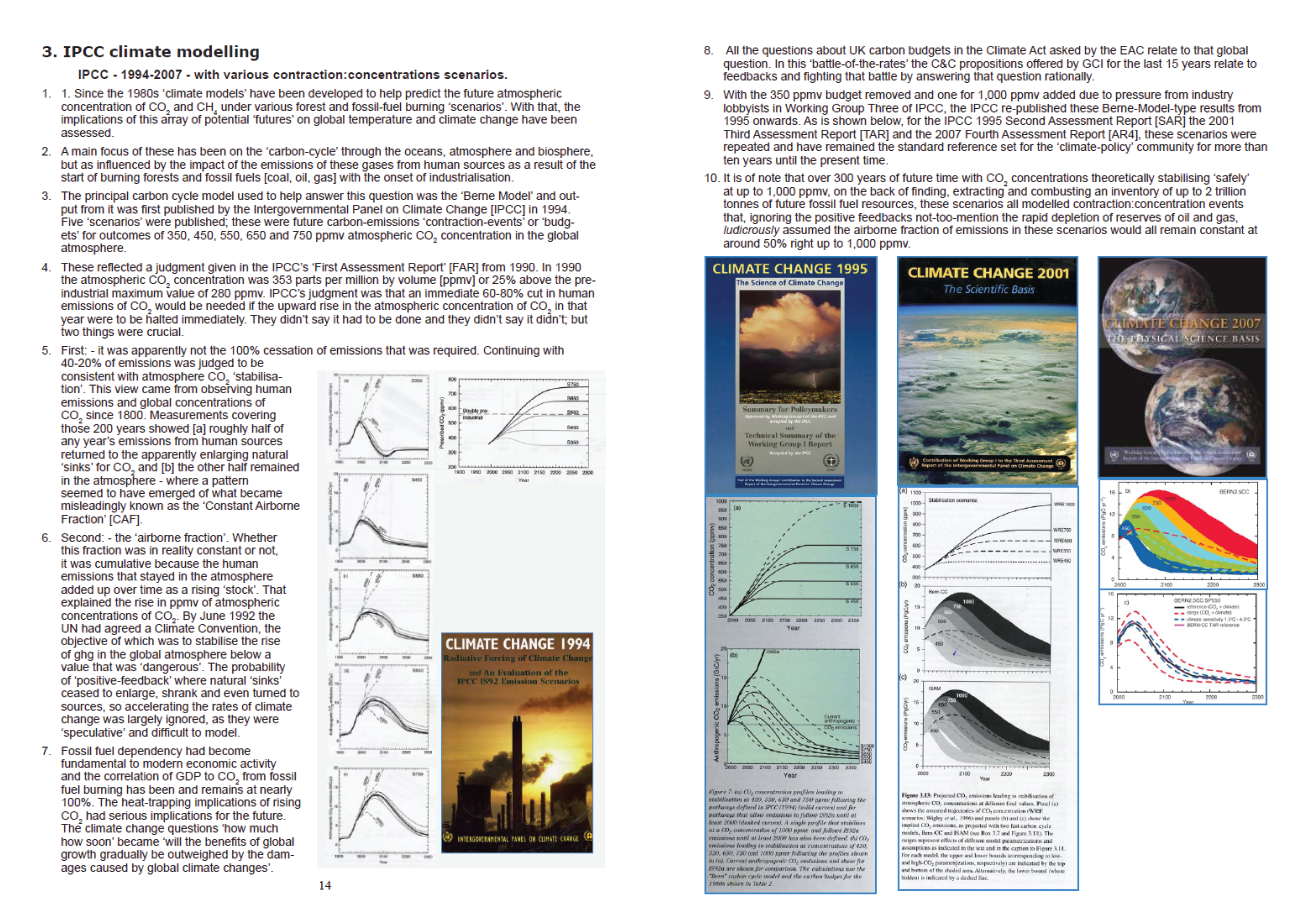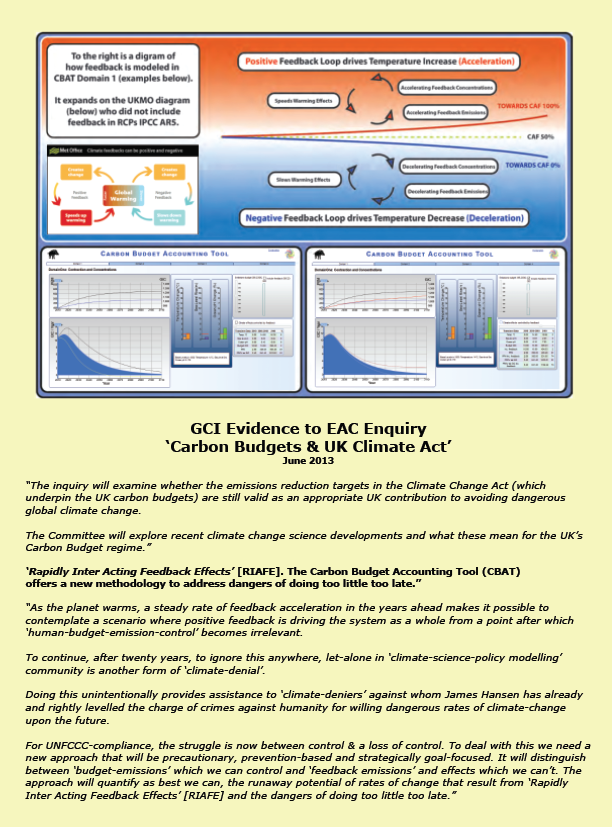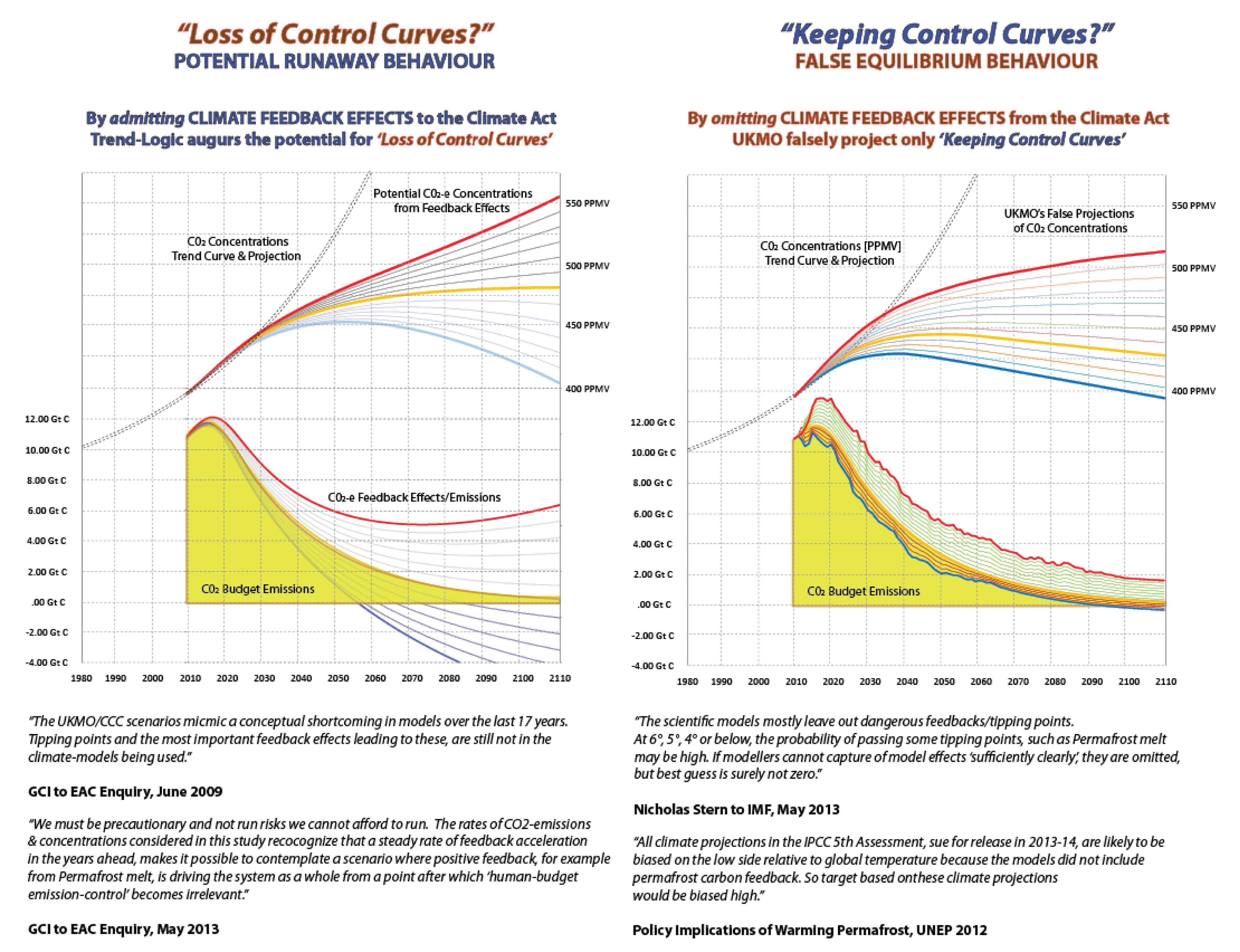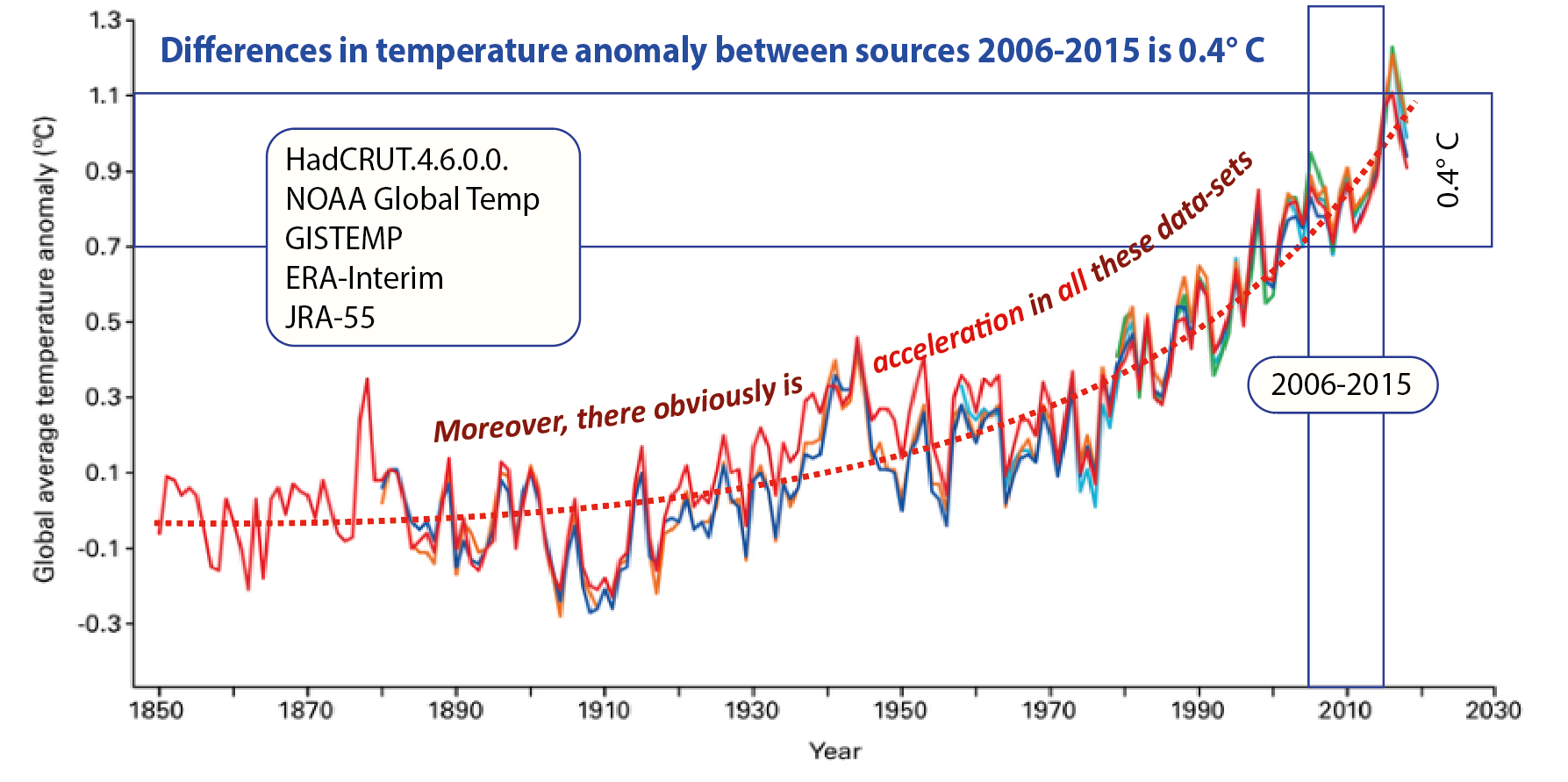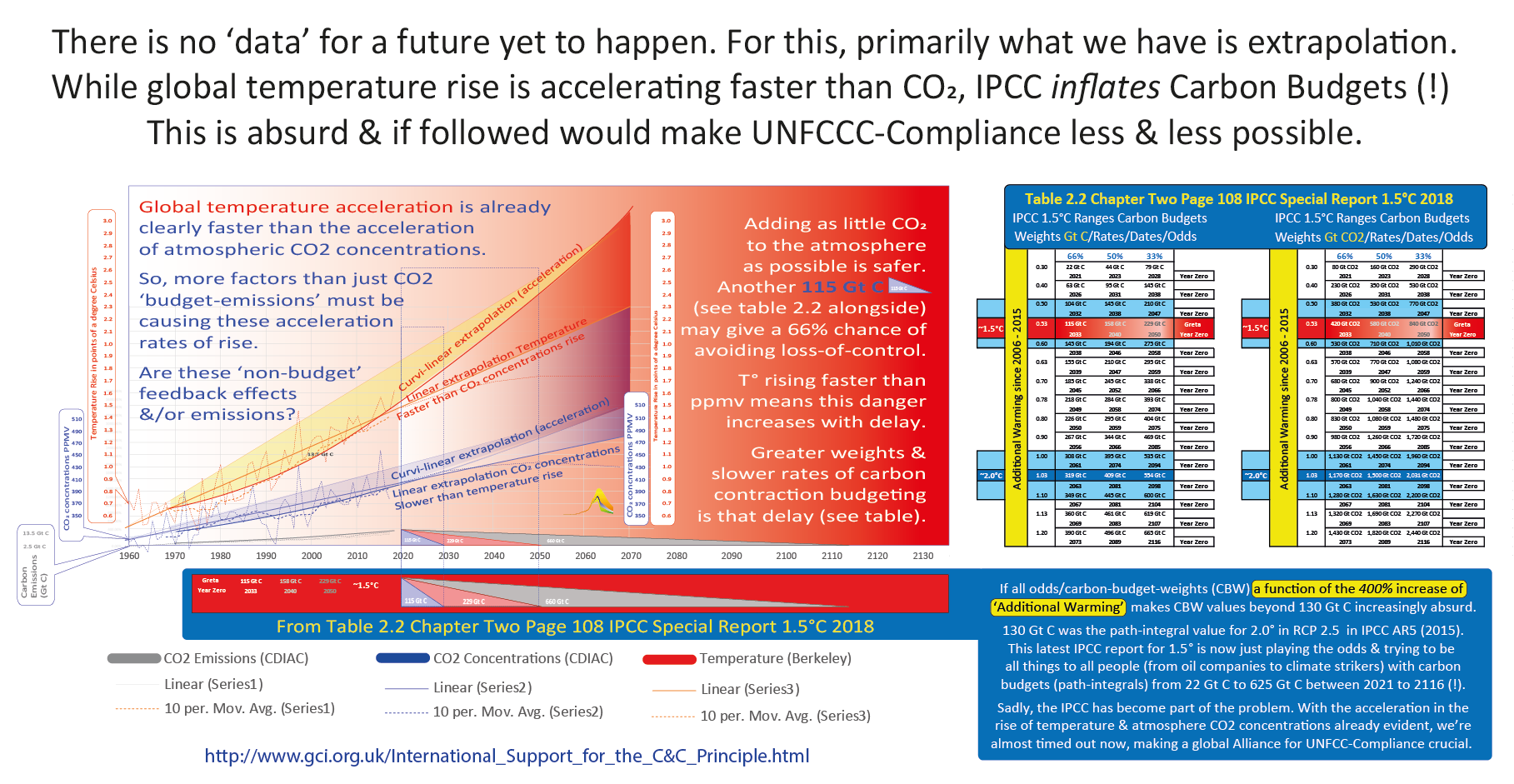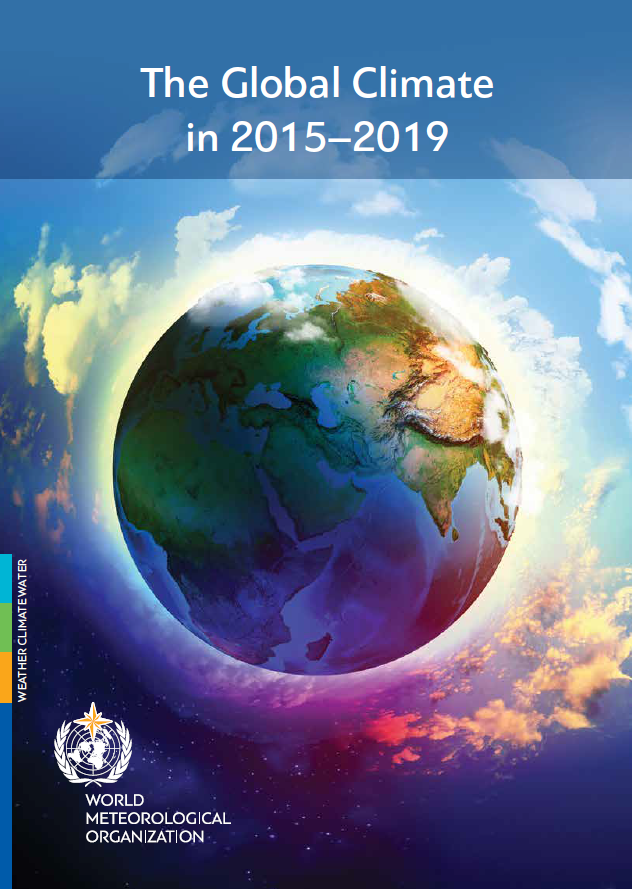IPCC SR 1994 - The Feedback Issue
- Greta Thunberg
- Greta Key messages
- Table 2.2
- Additional Warming Estimates
- Budget Integrals
- Budget Integrals per unit time
- the Feedback Issue - including the bath-tap-plug analogy
- the Feedback Issue and Table 2.2
- Acceleration; Early-Onset Runaway-Rates of Climate-Change
- We were lied to
- Adair Turner & the UK Climate Act
- Alliance for UNFCCC-Compliance
- International Support
Fossil Carbon Climate Models
The climate-models used by the IPCC started with the Berne Model. This was first presented in an IPCC special report presented in 1994.
It was a simple inorganic Fossil-Carbon Cycle Model (FCCM) that was comprised of a[a] tap (source-emissions)
[b] bath (atmosphere)
[c] plug (sink-emissions).
. . . where the water level in the bath, is the result of the flow rates between the tap and the plug.
Touch the picture below to cause the bath:tap:plug animation to play. It is a Flash file and it is safe.
It opens - with user-consent - in most browsers e.g Firefox Chrome etc if Flash-Reader is installed there.
In other words, this simple approach modelled: -
- bringing fossil carbon (i.e. inorganic carbon that has been out of the daily carbon flow for 100s of millions of years)
- into a bio-carbon flow daily cycling where
- ~80% 'fosssil' + ~20% -'bio' source-emission' (from oil coal & gas +Land Use Change =LUC) to the atmosphere & then partially back . . .
- on to 'non fossil source/sink-emissions' - i.e 'uptake' on land (by e.g. trees) & in the ocean ('biological pump')
- all involving a highly limited view of what are the full-earth-system range of biological/cognitive reactions to all this (i.e. feedback).
The 'Constant Airborne Fraction (CAF)
The rate within this limited flow cycle was that on average and on a cumulative basis: -
- the atmosphere retained just under half of the source-emissions the 'Constant Airborne Fraction' (CAF)
also known as the 'Fraction-Retained' (of the heat-trapping CO2)
- while the remainder was reabsorbed as ('sunk'-emissions)
also known as the 'Fraction-Returned' (of the heat-trapping CO2).All this was averaged over time as a 'Constant Airborne Fraction' (CAF) and this became the somewhat narrow, semi-rigid and primarily inorganic
physical basis of future carbon/climate modelling in the IPCC, which was periodically reviewed & collated into all subsequent IPCC ~ 5 yearly 'Assessments'.
Environmental Audit Select Committee (EAC) hearings in 2009
All this was described in this excerpt from GCI's submission to the first hearing by Environmental Audit Select Committee (EAC) in 2009,
on the question ‘Targets in the UK Climate Act: - Where did they come from? Were the models upon which they were based valid’?
Meteorologists at the UKMO and elsewhere had been quick to become involved in developing this lucrative weather-related climate-modelling. However, no amount
of £100 million pounds worth of Super-Cray-computing with 100-year high-resolution global-regional-local weather-forecasting really gets beyond that basic limitation.
The 'Not So-Constant' of CO2-defined 'Climate-Sensitivity'
The other 'constant' was the CO2 defined 'Climate Sensitivity'. This was the Radiative Forcing (RF) of global temperature rise per atmospheric CO2-doubling,
as against pre-industrial i.e. 280 Parts Per Million by Volume (PPMV) * 2 to 560 PPMV = T° * 2. The problem about defining 'Climate Sensitivity' as a function of
CO2 & then making CS the key reference in ascertaining the temperature response in the climate model, simply means that the performance and the output
of the model is CO2-based and/or CO2-equivalence-based, subordinating all other vectors to what inextricably remains CO2 based climate-modelling.
Climate-Sensitivity (or temperature rise) is a consequence of a range of interactive features (as integrated into CBAT - see below)
and much more than Climate-Sensitivity (a futile consensus of contraversies anyway) tied merely to CO2 doubling in FCCMs.The substantive issue here is 'ecology'. All life on Earth is part of the complex 'Web of Life', which means that it is about all organic (and not just inorganic) carbon flows.
Tied to CS, these simple fossil-carbon models fail to account for disturbing the equilibria in this complex web of behaviour, so output is becoming increasingly inaccurate & misleading.
ACCELERATION
Accounting for feedbacks means significant vectors (path-changes per-unit-time) that accelerate temperature and so aggravate general loss-of-control, include: -
- continued land-sink deterioration and dehydration
- leading to increasing combustibility and even the uncontrollability of forest-fires
- with continued degradation due to continued assaults on land-based biodiversity
- continued oceanic-sink deterioration due to increasing acidification due to continuing CO2 deposition,
- even as (theoretically) atmospheric CO2 concentrations might decrease
- with continued degradation of marine ecosystems and weakening of the oceans so-called 'biological pump'
- decreased albedo (reflectivity of solar radiation) due to ice-melt at the poles and in mountainous regions,
- additional greenhouse gas release and bacterial changes due to increasing permafrost melt
- soil degradation and decreasing food security combing with tropical disease migration . . .
- mass species migration, conflict & societal breakdown as temperature rises
- ecological system stress, continuing large scale extinction rates and system-event-horizons (tipping points)
- aggravating rates of climate change to overall Rapidly Inter-Acting Feedback Effect (RIAFE)
- where temperature-rises systemically merge into an acceleration of temperature-rise responding to itself (e.g. Permian Extinction)
- which are all indicative signs of early onset runaway rates of climate change.
One early expression of the shortcomings of this feedback-free approach became apparent as the UK Climate Act became law in 2008, which advocated an upper limit on
global temperature rise of 2.0° C. Noting merely the omission of melting Arctic ice from the model, 2.0° C was a temperature limit declared by James Hansen as 'not safe'.
The Feedback-Free 'Representative Concentration Pathways' (RCPs)
UKMO climate modellers behind the UK Climate Act also projected that global carbon-sinks would (as a function of 'coupled carbon cycling') increasingly absorb more than global carbon sources as emissions came down. This became the basis of RCP 2.5 the weight of which budget (2020-2085) is 229 GtC but which is now claimed by IPCC to give 33% odds for 1.5° C
With the evermore urgent advocacy of articifical sink-enhancement, this optimism is now regarded as unjustified and outmoded.
The feedback-free deficiency became clearer still with the 4 so-called Representative Concentration Pathways (RCPs) introduced in 2010. Feedback-free, these were the basis of the
preparations for the IPCC 5th Assessment & its Summary-for-Policy-Makers, that would be published in 2015, concurrent with the Paris Agreement & its call for a 1.5° C limit.
In 2010 it became clear that RCP 8.5 raised the upper limit on CO2 concentrations from what it had been at 1000 PPMV to ~2000 PPMV with an upper temperature limit 10° C!
When I enquired as to who had been responsible for this utterly astonishing decision, I was eventually told by the UKMO that, "look - it was a bunch of guys - OK!"
It is worth noting in AR4 IPCC published significant carbon budget shrinkage between uncoupled emissions & coupled emissions (all models) in the 1000 ppmv animation above.
Environmental Audit Select Committee (EAC) hearings in 2013
Seeking to facilitate the change of conceptual approach needed, GCI introduced the Carbon Budget Analysis Tool (CBAT) with Feedback Looping
GCI's Key Message 'ACCELERATION' - Rapidly Inter Acting Feedback Effects [RIAFE].
"The Carbon Budget Accounting Tool (CBAT) offers a new methodology to address dangers of doing too little too late.
As the planet warms, a steady rate of feedback acceleration in the years ahead makes it possible to contemplate a scenario where
positive feedback is driving the system as a whole from a point after which ‘human-budget-emission-control’ becomes irrelevant.
To continue, after twenty years, to ignore this anywhere, let-alone in ‘climate-science-policy modelling’ community
is another form of ‘climate-denial’.
Doing this unintentionally provides assistance to ‘climate-deniers’, against whom James Hansen has already and rightly levelled
the charge of crimes against humanity for willing dangerous rates of climate-change upon the future.
Key Battle for UNFCCC-compliance
The struggle is now between 'Keeping-Control' & 'Loss of Control'.
To deal with this we need a new approach that will be precautionary, prevention-based and strategically goal-focused.
It will distinguish between ‘budget-emissions’ which we can control and ‘feedback emissions’ and effects which we can’t.
The approach will quantify as best we can, the runaway potential of rates of change that result from ‘Rapidly Inter-Acting
Feedback Effects’ [RIAFE] and the dangers of doing too little too late.”
Taking the UK Climate Act as the default position, CBAT offers a way to extend cognitively the science/precaution-equity-policy interface
(as per the UNFCCC) to make very clear with user-chooser arrays, the utterly crucial distinction and the huge uncertainties between: -
- 'Budget' fossil carbon, including emissions from oil coal and gas & emissions from Land-Use Change (LUC) &
- 'Non-budget' (non-fossil) feedback-emissions & effects to recognize generically the potential shape, scale & impact of these in excess of CAF 50.
- while reconciling all these with a range of values for climate sensitivity, rates of technology transition and the $-value of climate-damages rising in proportion to delay
- in other words future climate modelling where 'equilibrium-seeking' is the default, is contrasted with progressive loss-of-equilibrium as concentrations and temperature rise.
With all witnesses to Parliament under oath, the reception from the UKMO at EAC Enquiries was unexpectedly hostile. Their chief scientific officer (Dr Julia Slingo), simply insisted
on the major role they played in the IPCC, whilst also dishonestly denying that they had omitted any feedbacks at all from their so-called 'full-earth-system' climate models.This denial was completely untrue and specifically rebutted by DECC in 2016. However, the fossil-fuel-centric modelling community continues to this day, quasi-feedback-free
while remaining subject to the dysfunction of the $-numeraire & the extinction-oriented bathos of the odds-based casino-economic-growth that follows from that.
That is something more than simply bad habits and/or worse than mere bias. Some climate-scientists are now saying that the fossil carbon modellers
should admit their failures to predict the mess we're in. Some are saying we have to change our approach to this crisis.
Approval for CBAT
Some climate scientists were among those who contributed to the approving reception of CBAT Afterall, CBAT did accurately project the
'loss of control' curvature we start to see in the curves (what David Attenborough now calls "the tragic desperate mess" we're now in).
Early onset stage of loss-of-control - i.e. runaway rates of climate change - has begun.
There is now quite obviously trend-average-acceleration in all these temperature data-sets below (1860 - 2020)
which is indicative of Loss-of-Control & not Keeping-Control.
However, there has also been a quite remarkable effort to ignore, avoid, supress or deny this.
The reason for this is would appear to be simple. To admit acceleration in the rise of temperature,
is to admit the loss of control curvature (predicted by GCI at EAC in 2013) which is politically explosive.
When atmospheric CO2 concentrations are accelerating upwards, then temperature is accelerating upwards by definition.
If that were not so, it would mean that the entire exercise of carbon cycle modelling in IPCC was based on a false premise.
The difficulty we now face is in acknowledging that: -
- CO2 concentrations are accelerating [a] and that
- temperature is accelerating [b] and crucially that
- [b] is accelerating faster than [a] - as here . . . these curvilinear trends come out of averaging the data.
In other words: -
- something more than just acceleration in CO2 emissions:concentrations
is driving temperature acceleration - there is some mix of positive feedback
vectors involved here, compounding the overall rates of change
- faster acceleration in temperature than in CO2 emissions:concentrations
means simply that trying to control temperature by reducing CO2 emissions
is inadequate and increasingly futile in proportion to any further delay
- What is certain is that in the first phase, reducing CO2 emissions globally
at best only slows the rise of CO2 concentrations globally
- What is also certain is that in the first phase, slowing the rise in CO2 concentrations
translates into less than one-for-one slowing of the rise in temperature
- What is also certain is that we have a very limited understanding of full-earth-system
bio-physical feedback dynamics and there is still precious little of that in the FCCMs.
- So what all this inexorably means is that we are already in the early onset stages of
loss-of-control i.e. runaway rates of climate change and
- This is really what global climate emergency means (we are losing control) and this is not
across Centuries or decades or even just years, it means hourly daily as
- we continue to add fossil carbon to the atmosphere at more that twice the rate
at which we should be removing it 66% odds for 1.5 means ~ -230 GtC/second globally
- which shows why emergency measures are needed and the global carbon budget needs
rapid contraction and additional mitigation techniques are needed without delay.
Take for example the latest report from the World Meteorological Organisation.
In the Executive Summary, acceleration in the rise of atmospheric CO2 concentrations is acknowledged.
"Compared to the previous five-year assessment period 2011–2015, the current five-year period 2015–2019 has seen a continued
increase in carbon dioxide (CO2) emissions and an accelerated increase in the atmospheric concentration of major greenhouse
gases (GHGs), with growth rates nearly 20% higher. The increase in the oceanic CO2 concentration has increased the ocean’s acidity."
In the Executive Summary acceleration in the rise of temperature is specifically not acknowledged.
"The five-year period 2015–20191 is likely to be the warmest of any equivalent period on record globally, with a 1.1 °C global temperature
increase since the pre-industrial period and a 0.2 °C increase compared to the previous five-year period."
(This is ridiculous; temperature rise is obviously also accelerating).
In the Executive Summary, acceleration in the trends acknowledged.
"Continuing and accelerated trends have also predominated among other key climate indicators, including an acceleration of rising
sea levels, a continued decline in the Arctic sea-ice extent, an abrupt decrease in Antarctic sea ice, continued ice mass loss in the glaciers
and the Greenland and Antarctic ice sheets, and the clear downward trend in the northern hemisphere spring snow cover."
The IPCC has also been involved in this suppression of acknowledging that early onset runaway rates of climate change has begun
Others note the fiasco that developed after the IPCC AR5 was published. The IPCC hopelessly tried to explain away after all the 'peer-review'
and much gerrymandering, that RCP 8.5 actually didn't mean the Permian Extinction after all, as Nature Magazine had inconveniently pointed out.
What it meant was after delaying the scenarios by ~50-100 years, that the actual temperature range for RCP 8.5 was between 2 & 12 degrees Celsius!

In brief, with more and more fossil carbon being brought into the biosphere on a daily basis and with increasing stress becoming evident on the ecological equilibria upon which life depends, climate-modelling in the IPCC is increasingly proving now to be becoming part of the problem.


